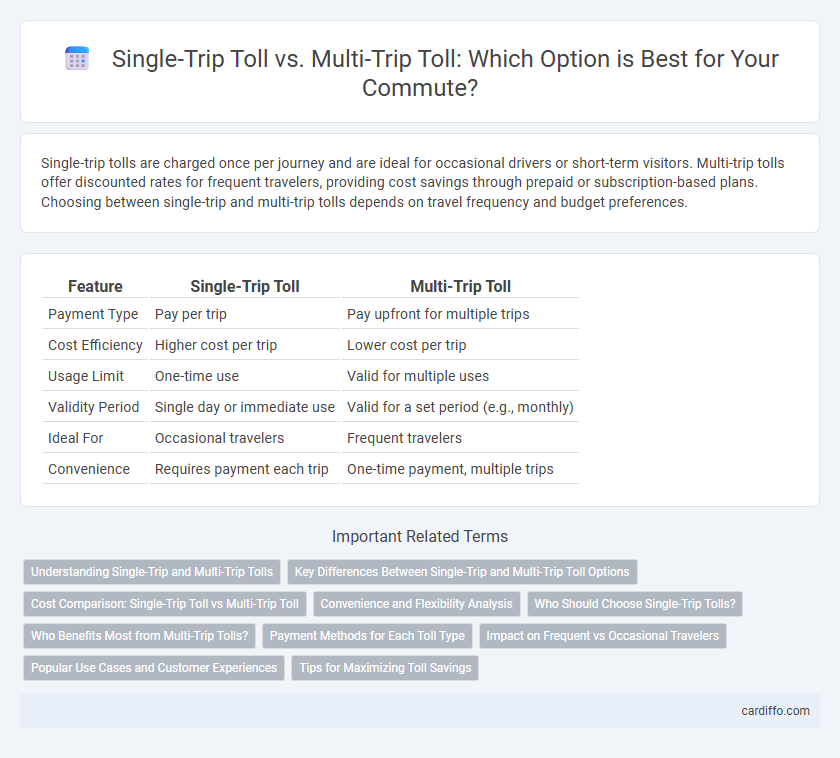Single-trip tolls are charged once per journey and are ideal for occasional drivers or short-term visitors. Multi-trip tolls offer discounted rates for frequent travelers, providing cost savings through prepaid or subscription-based plans. Choosing between single-trip and multi-trip tolls depends on travel frequency and budget preferences.
Table of Comparison
| Feature | Single-Trip Toll | Multi-Trip Toll |
|---|---|---|
| Payment Type | Pay per trip | Pay upfront for multiple trips |
| Cost Efficiency | Higher cost per trip | Lower cost per trip |
| Usage Limit | One-time use | Valid for multiple uses |
| Validity Period | Single day or immediate use | Valid for a set period (e.g., monthly) |
| Ideal For | Occasional travelers | Frequent travelers |
| Convenience | Requires payment each trip | One-time payment, multiple trips |
Understanding Single-Trip and Multi-Trip Tolls
Single-trip tolls require payment each time a specific road or bridge is used, making them ideal for occasional travelers or one-time use. Multi-trip tolls offer discounted rates or prepaid options for frequent users, enhancing convenience and cost efficiency over repeated journeys. Understanding these options helps drivers select the most economical and practical toll payment method based on travel frequency.
Key Differences Between Single-Trip and Multi-Trip Toll Options
Single-trip tolls apply to one-time usage of a toll road or bridge, typically requiring payment at each crossing, making them ideal for infrequent travelers or one-time trips. Multi-trip tolls offer discounted rates or prepaid plans for repeated use over a set period, providing convenience and cost savings for regular commuters or frequent travelers. The key differences lie in payment frequency, cost efficiency, and convenience, with multi-trip options designed to streamline travel and reduce overall expenses.
Cost Comparison: Single-Trip Toll vs Multi-Trip Toll
Single-trip tolls require payment each time a vehicle passes through a toll point, often resulting in higher costs for frequent travelers. Multi-trip toll systems offer discounted rates by allowing multiple uses under a single payment plan, significantly reducing the average cost per trip. For drivers covering regular routes, multi-trip tolls present better cost efficiency and budget predictability compared to single-trip toll payments.
Convenience and Flexibility Analysis
Single-Trip Toll offers convenience for infrequent travelers by eliminating the need for long-term commitments, making it ideal for occasional use. Multi-Trip Toll enhances flexibility by providing cost savings and streamlined access for regular commuters or frequent travelers, allowing unlimited passage within a specified period. Analyzing travel patterns reveals that Multi-Trip Tolls maximize value through repeated use, while Single-Trip Tolls prioritize simplicity and one-time payment ease.
Who Should Choose Single-Trip Tolls?
Single-trip tolls are ideal for infrequent travelers or those making one-time journeys where the cost-effectiveness of multi-trip passes is not justified. These tolls provide flexible access without long-term commitments, making them suitable for occasional commuters, tourists, or business visitors. Choosing single-trip tolls allows users to pay only for their exact trips, avoiding unnecessary expenses associated with unused multi-trip credits.
Who Benefits Most from Multi-Trip Tolls?
Frequent commuters and logistics companies benefit most from multi-trip tolls due to significant cost savings over multiple journeys compared to single-trip toll charges. Multi-trip tolls offer discounted rates and convenient prepayment options, reducing administrative overhead and improving cash flow management. These benefits make multi-trip tolls ideal for businesses and individuals with consistent travel routes, maximizing financial efficiency.
Payment Methods for Each Toll Type
Single-trip toll payments typically accept cash, credit, or debit cards for one-time use, while multi-trip toll systems often utilize electronic toll collection methods such as RFID tags, prepaid accounts, or mobile apps for seamless, automatic payments. Electronic payment methods in multi-trip tolls reduce transaction times and eliminate the need for cash handling, enhancing convenience for frequent travelers. Single-trip tolls offer flexibility for occasional users, whereas multi-trip tolls provide cost efficiency and faster processing through digital payment integration.
Impact on Frequent vs Occasional Travelers
Single-trip tolls impose higher costs per journey, disproportionately affecting frequent travelers by accumulating expenses quickly, while occasional travelers face minimal impact. Multi-trip tolls offer discounted rates or subscription models, reducing overall costs for regular users and incentivizing consistent travel. Choosing the appropriate toll structure balances revenue generation with traveler affordability, crucial for managing traffic flow and commuter satisfaction.
Popular Use Cases and Customer Experiences
Single-trip toll passes are ideal for occasional travelers and tourists who require payment for a one-time journey, offering simplicity and immediate access without long-term commitment. Multi-trip toll passes benefit frequent commuters and commercial drivers by providing cost savings, faster toll processing, and seamless travel across multiple toll points. Customers report enhanced convenience and reduced wait times with multi-trip passes, while single-trip options are praised for their flexibility and accessibility.
Tips for Maximizing Toll Savings
Choosing a multi-trip toll pass over single-trip toll payments significantly reduces overall expenses, especially for frequent travelers on toll roads. Leveraging electronic toll collection systems such as E-ZPass or SunPass offers convenient automatic payments and discounted toll rates. Planning routes using toll-saving apps and avoiding toll roads during peak hours further maximizes savings by minimizing unnecessary toll fees and traffic congestion.
Single-Trip Toll vs Multi-Trip Toll Infographic

 cardiffo.com
cardiffo.com